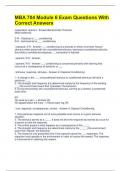MBA 704 Module 6 Exam Questions With
Correct Answers
respondent, operant - Answer-Behavioristic Theories:
Most traditional
S-R - Classical or ___ conditioning
R-S - Instrumental or ___ conditioning
/.classical, S-R - Answer-___ conditioning is a process in which a formerly neutral
stimulus when paired with an unconditioned stimulus, becomes a conditioned stimulus
that elicits a conditioned response: __ connection is learned
/.operant, R-S - Answer-
/.operant, R-S - Answer-___ conditioning is concerned primarily with learning that
occurs as a consequence of behavior or ___
/.stimulus, response, stimulus - Answer-In Classical Conditioning:
1. A change in the ___ (unconditioned stimulus to conditioned stimulus) will elicit a
particular ___.
2. The strength and frequency are determined mainly by the frequency of the eliciting
___ (the environment event that *precedes* the behavior)
3. During the process; the unconditioned stimulus, serving as a reward, is presented
every time.
EX:
(S) stuck by a pin --> flinches (R)
(S) tapped below the knee --> flexes lower leg (R)
/.cue, response, consequences, correct - Answer-In Operant Conditioning:
1. One particular response out of many possible ones occurs in a given stimulus
situation.
2. The stimulus serves as a ____. It does not elicit the response but serves as a cue for
a person to emit the response.
3. The critical aspect is what happens as a consequence of the ____.
4. The strength and frequency are determined mainly by the _____ (the environment
event that *follows* the behavior)
5. The reward is only presented only if the organism gives the ___ responses. The
organism must operate in the environment in order to receive the reward. The response
is instrumental in obtaining the reward.
,*Must greater impact on human learning*
Ex:
(R) works --> paid (S)
(R) enters a resturant --> obtains food (S)
/.repondent - Answer-___ (reflexive) behaviors are involuntary responses that are
elicited by a stimulus
/.cognitive, structures, processes - Answer-___ learning consists of a relationship
between cognitive environment cues and expectation. (Tolman, white rat)
Depicted as S-S, or learning the association between the cue and the expectancy.
Today, this learning focuses more on ___ and ___ of human competence rather than on
the acquisition and transition processes that have dominated learning theory
explanations.
/.insight - Answer-___ learning is when the solution to the problem appeared as a
whole, not as a series, gradual shaping of new responses as the operant approach
/.motivation - Answer-The cognitive approach has been applied mainly to ___ theories.
1. expectations
2. attributions
3. locus of control
4. goal setting
/.theoretical - Answer-The __ approach to learning was the first to combine and
integrate both behavioristic and cognitive concepts and emphasized the interactive,
reciprocal nature of cognitive, behavioral, and environmental determinants.
/.social, vicarious, modeling, self-control - Answer-___ learning draws from the
principles of classical and operant conditioning and goes beyond them by recognizing
that there is more to learn than direct learning via antecedent stimuli and contingent
consequences. Learning takes place via:
1. ____
2. ____
3. ____ processes
/.cognition, symbolizing, forethought, vicarious/modeling, self-regulation, self-efficacy -
Answer-social ___ theory extends learning and/or modifying behavior by giving more
attention to self-regulatory mechanisms. Identifies 5 capabilities that people use to
*initiate, regulate, and sustain their behavior*
1.
2.
, 3. ____ learning
4.
5.
/.modeling, self-efficacy - Answer-A closer look at social learning through the social
cognitive derivatives of ___ and ___ can lead to better understanding of learning and
contribute to the theoretical underpinning of behavior performance management.
/.observational - Answer-The vicarious, or modeling, processes essentially involve ___
learning.
/.modeling - Answer-___ (aka imitating) in accordance with social learning theory can
account for certain behavior acquisition phenomena that cannot be easily fitted into
either operant or respondent conditioning. Learn from others in 2 ways:
1. the person observes how others act and then acquired a mental picture of the act and
its consequence
2. the person acts out the acquired image, and if the consequences are positive, he or
she will tend to do it again. Visa Versa with negative. Both tie to operant learning.
Goes beyond operant due to cognitive. It involves subprocesses, such as attention,
retention, and motoric reproduction
/.self-efficacy - Answer-____, from psycap, is the beliefs in one's capabilities to organize
and execute the course of action required to produce given attainments.
/.reinforcement, punishment, reinforcement - Answer-___ and ___ play a central role in
the learning process and provide evidence-based principles for behavioral performance
management. Most experts agree than ___ is more important.
/.effect - Answer-law of ___ states that of several responses made to the same
situation, those which are accompanied or closely followed by satisfaction
(reinforcement) will be more likely to recur; than those accompanied or closely followed
by discomfort (punishment)
/.extinction - Answer-___ principle of law states that if a behavior has no consequences
over time the behavior will stop
/.reinforcement - Answer-___ is anything that both increases the strength and tends to
induce repetitions of the behavior that preceded the reinforcement. It strengthens the
behavior preceding it and induces repetitions
/.reward - Answer-___ is something that the person who presents it deems to be
desirable





